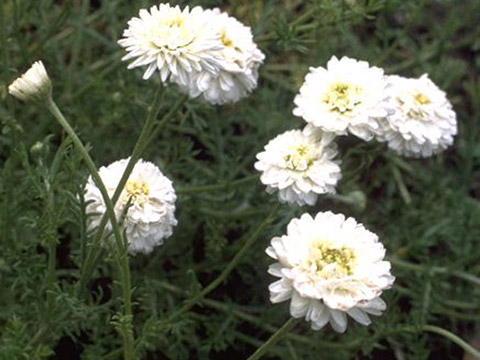Botanical name
Chamaemelum nobile (L.) All.
Family
Asteraceae
Common name
Garden Chamomile, English Chamomile
Information about the plant
Roman chamomile is native to southern and western Europe and North Africa, and has been naturalized in central Europe, including Germany. Its foreign origin is reflected in its German name, ‘Römische’ (Roman) chamomile. The genus name Chamaemelum is derived from the Latin ‘chamaemelon’ (= chamomile), which was borrowed from Greek and means ‘earth apple’, referring to the delicate apple-like scent of the flowers (Greek ‘chamai’ = on the ground, stretched out, low; ‘melon’ = apple).
Roman chamomile grows to a height of 20 to 50 cm and has double to triple pinnate leaves with elongated leaflets. The flower heads are 2 to 2.5 cm in diameter and stand individually on long flower stalks. Yellow tubular flowers surrounded by 12 to 15 white ray florets are arranged on a conical, domed receptacle, making them very similar to the flower heads of true chamomile. However, unlike true chamomile, the receptacle is covered with bracts and is pithy when cut lengthwise, rather than hollow.
The cultivated variety of Roman chamomile grown for medicinal purposes has double flowers, which means that it has significantly more ray florets arranged in several circles and only a few tubular florets. Roman chamomile likes to grow along the edges of paths and fields, as well as on the banks of standing water. It flowers from May to September.
Medicinally used parts of plants (herbal drug)
The dried flower heads of the cultivated, double-flowered variety (Roman chamomile - Chamomillae romanae flos) are used. Their characteristic scent is caused by the essential oil stored in glandular scales on the flower surface, which is released when these glands are crushed.
The commercially available drug is sourced from France, Belgium, and Poland.
Constituents of the herbal drug
Roman chamomile contains essential oil, sesquiterpene lactone bitter compounds, flavonoids, and acetylenes.
Quality of the drug
The quality of Roman chamomile (Chamomillae romanae flos) is specified in the European Pharmacopoeia (Ph. Eur.).
Medical applications
Recognised medical use
The HMPC has classified Roman chamomile flowers as a traditional herbal medicinal product (see ‘Traditional use’).
ESCOP: Internally for mild dyspeptic complaints such as bloating, nausea, flatulence, and loss of appetite: Externally for mild inflammation of the oral mucosa and skin (wounds and abrasions). Also for itching, eye irritation, and eye complaints. These applications are based on long-standing use in humans.
Traditional use
Roman chamomile flowers have been classified by the HMPC as a traditional herbal medicinal product (Article 16a of Directive 2001/83/EC). Based upon long-standing use, Roman chamomile flowers can be used to treat mild cramp-like gastrointestinal symptoms associated with bloating and flatulence.
Herbal drug preparations in finished dosage forms
- Roman chamomile flowers for tea preparation
- Alcoholic extracts in liquid preparations
Dosage
Finished medicinal product: See patient information leaflet.
Tea: Drink one cup of freshly prepared Roman chamomile tea, warm, between meals three times a day. Daily dose up to 12 g of the drug.
Preparation of a tea
Pour 150 ml of boiling water over 1 to 4 g of finely chopped Roman chamomile and strain after 10 minutes.
Notes
Individuals with known allergies to Asteraceae should avoid consuming preparations containing Roman chamomile flowers (possible cross-allergy).
No studies have been published on the safety of Roman chamomile during pregnancy and lactation. The use in children under 12 years of age is not recommended due to a lack of evidence.
Side effects
Allergic reactions may occur.
Interactions
As a precaution, Roman chamomile flowers should not be taken internally by individuals using aspirin, warfarin, or other blood-thinning medications, nor should they be taken in combination with diazepam and other benzodiazepines.
References
Herbal drug monographs
HMPC (2012, 2020), ESCOP (2019).
Further literature
Commentary on the European Pharmacopoeia (Roman chamomile, No. 0380).


